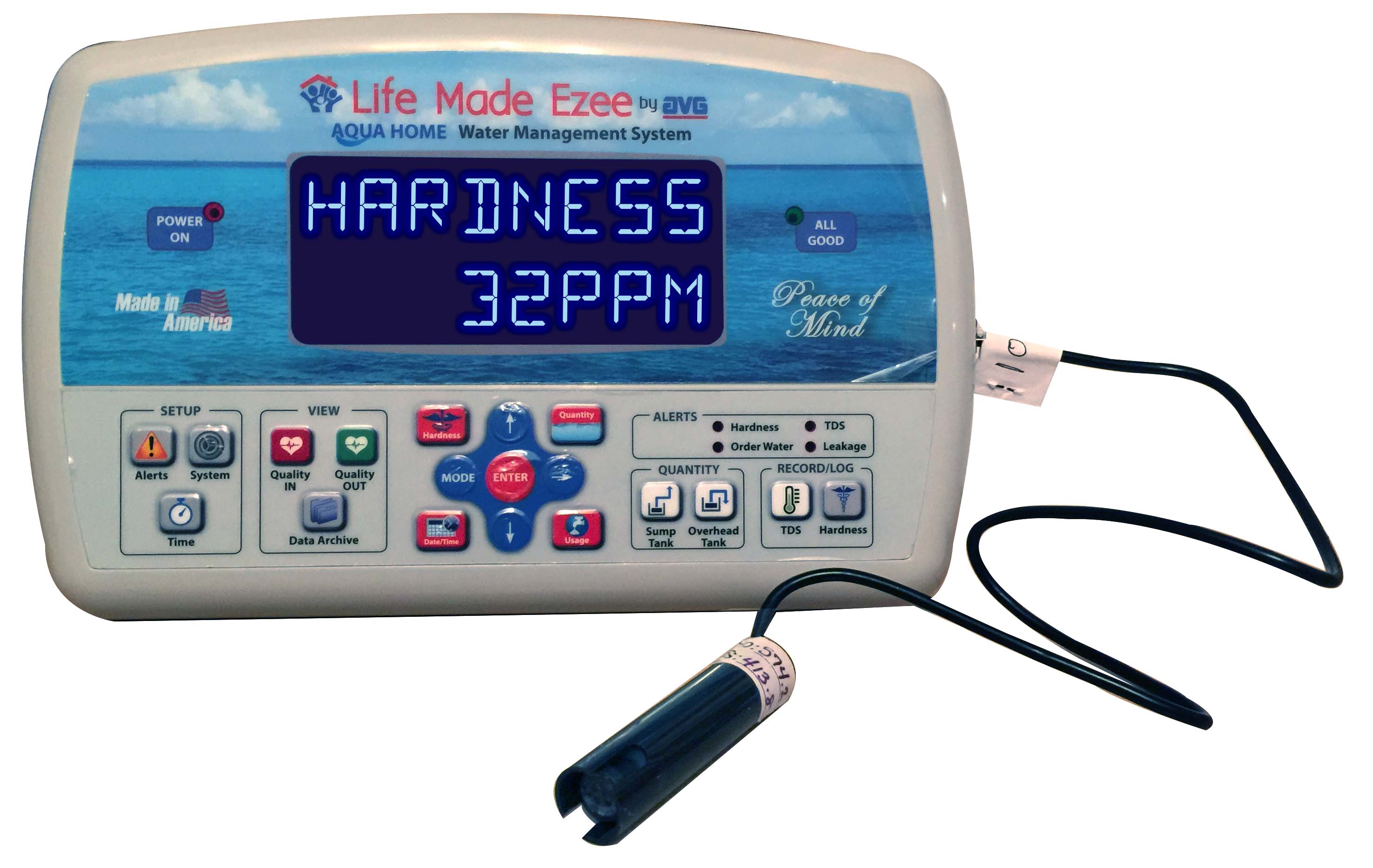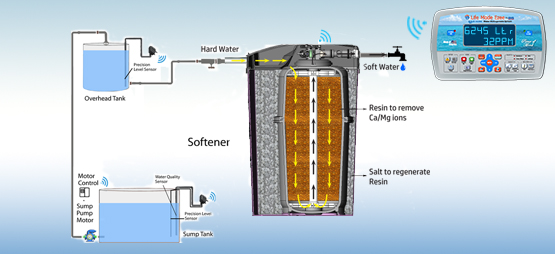Water Quantity, Quality and Usage Measurement & Control through RFION™ Technology
No-Contact water level sensors: LME-WMS employs the latest in water level sensing technology without use of any level sensors that come in contact with water in the sump or overhead tank. This avoids failure and high maintenance of contact sensors that get corroded with water with high mineral and metal content. These water contact sensors even when fully functional provide only the level of water where the installer has mounted the sensor. For example if the sensor is mounted at about 50% of the height of the tank, it would give an indication that the water level is 50%. If you want to know if the water in the tank is more than 500 liters, you will have to call the installer to readjust the sensor manually. LME-WMS uses load or pressure monitoring technology to accurately measure the height of water in the respective tank, which leads to the calculation of liters in the tank once the installer enters the sq. ft. area of the tank. After LME service engineer installs the load sensors of the WMS, the water quantity is displayed on the Main Data and Control Panel of the LME-WMS. The load sensor provides an analog value that is converted to a digital number and shown in liters. The system shows the total water in the home, in the Sump tank, in the Overhead tank and Total.
 TDS and Temperature sensors: TDS is another measure of the quality of water also measured in PPM. TDS measurement can also provide an approximate value of water hardness before the water is softened. TDS stands for Total Dissolved Solids that contribute to the conductivity of water. RO produced drinking water should have a near zero TDS value. The LME-WMS incorporates two sets of TDS and Temperature sensors, one in the Sump tank and the second with a probe that plugs into the Main Data and Control Panel, that can be used to measure the TDS of tap water or any other water you wish to check. It should be noted that softened water has the same TDS value as the pre-softened water because the amount of total dissolved solids is the same. Softening the water only substitutes the Calcium and Magnesium ions with Sodium ions, so the total dissolved solids remain the same. For example, if the incoming water has a TDS of 500 PPM and hardness of 300 PPM, the softened water would have a TDS of about the same as 500 PPM, but the hardness would go down to 20 or so PPM. Sump TDS sensor provides an approximate value of the hardness as well as other minerals or metals in the Sump tank.
TDS and Temperature sensors: TDS is another measure of the quality of water also measured in PPM. TDS measurement can also provide an approximate value of water hardness before the water is softened. TDS stands for Total Dissolved Solids that contribute to the conductivity of water. RO produced drinking water should have a near zero TDS value. The LME-WMS incorporates two sets of TDS and Temperature sensors, one in the Sump tank and the second with a probe that plugs into the Main Data and Control Panel, that can be used to measure the TDS of tap water or any other water you wish to check. It should be noted that softened water has the same TDS value as the pre-softened water because the amount of total dissolved solids is the same. Softening the water only substitutes the Calcium and Magnesium ions with Sodium ions, so the total dissolved solids remain the same. For example, if the incoming water has a TDS of 500 PPM and hardness of 300 PPM, the softened water would have a TDS of about the same as 500 PPM, but the hardness would go down to 20 or so PPM. Sump TDS sensor provides an approximate value of the hardness as well as other minerals or metals in the Sump tank.
 LME-WMSWater Softener: As described in considerable detail, the LME-WMS employs a revolutionary first of its kind closed loop water softener that not only displays the hardness of water, it automatically controls it to the level you set.
LME-WMSWater Softener: As described in considerable detail, the LME-WMS employs a revolutionary first of its kind closed loop water softener that not only displays the hardness of water, it automatically controls it to the level you set.
Automatic Pump Control: LME-WMS features automatic control of the Sump pump motor to maintain the quantities of water user wishes to have in each tank. The sump pump control is incorporated in the Sump Sensor and Control module of the WMS that also communicated wirelessly to main panel.
Usage Data and Alerts: The main MDCP panel of the WMS is an highly intelligent device. The system as a whole is employing four microprocessors working in conjunction with each other. This allows the WMS to collect and display usage data as to daily use of water, weekly use of water, monthly use of water, history of TDS data, Hardness data, Quality data as well as history of all alerts generated by the system. Set point for Alerts, like minimum quantity of water at home, minimum quantity of water in the sump tank, maximum amount of water pumped into the overhead tank, high TDS alert, order water alert, Hardness setting and alerts and a composite Quality alert. Audible sound alerts are also provided with user option to silence the audio alerts.
 Wireless RF Communication: All subsystems or components of the LME-WMS communicate to each other with RF wireless technology using LORA spectrum. This eliminates the need to rewire the existing home disturbing the décor of the home besides causing serious convenience to the home owner. It should be noted however that all the sub systems require a source of power, even though minimal, less than 50 watts in total. The WMS comes with Power modules that plug into the Mains. Current LME-WMS has been tested to work up to 8 floors in a normal building. A Repeater is planned to be introduced in near future to go to higher levels.
Wireless RF Communication: All subsystems or components of the LME-WMS communicate to each other with RF wireless technology using LORA spectrum. This eliminates the need to rewire the existing home disturbing the décor of the home besides causing serious convenience to the home owner. It should be noted however that all the sub systems require a source of power, even though minimal, less than 50 watts in total. The WMS comes with Power modules that plug into the Mains. Current LME-WMS has been tested to work up to 8 floors in a normal building. A Repeater is planned to be introduced in near future to go to higher levels.